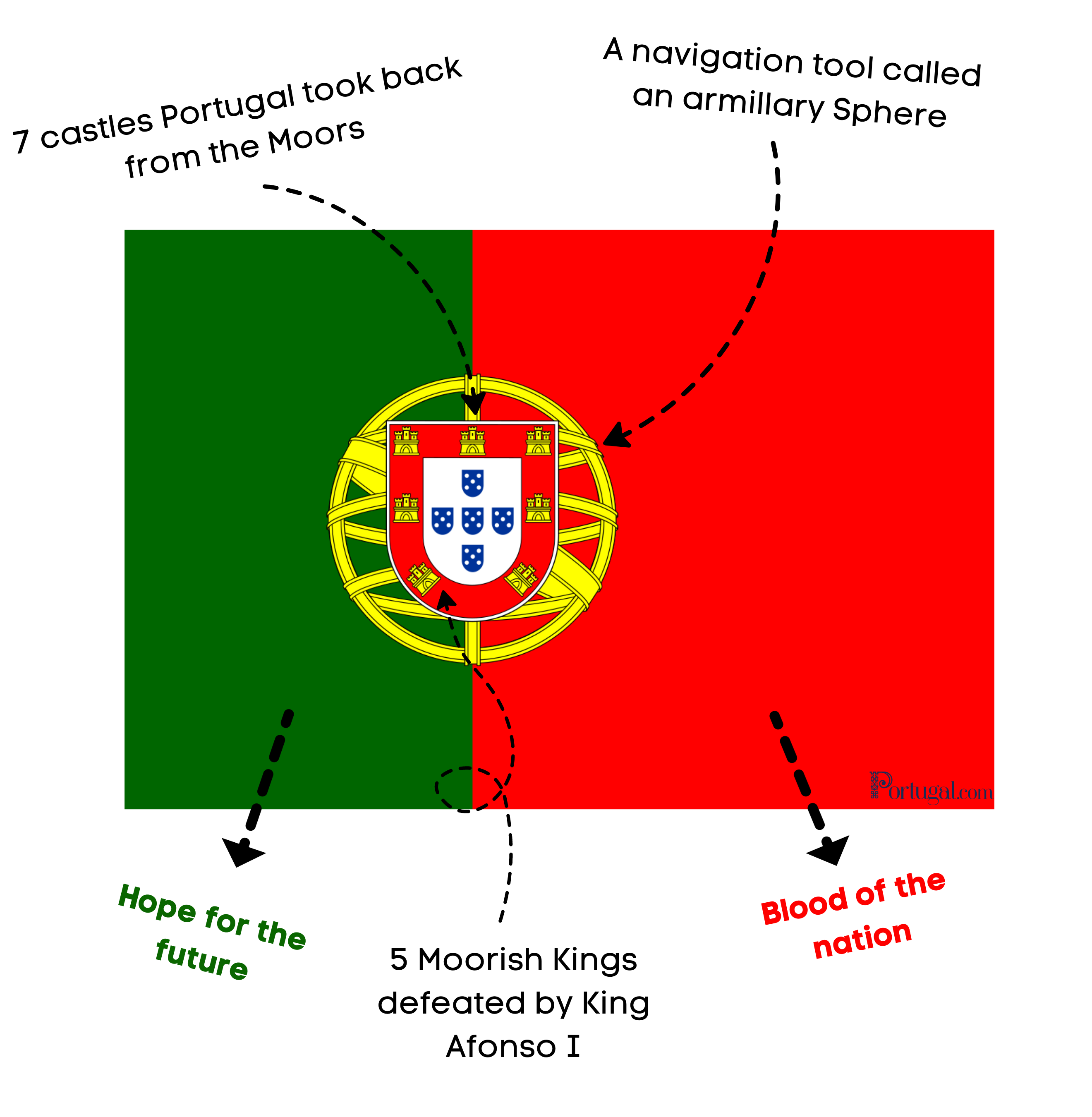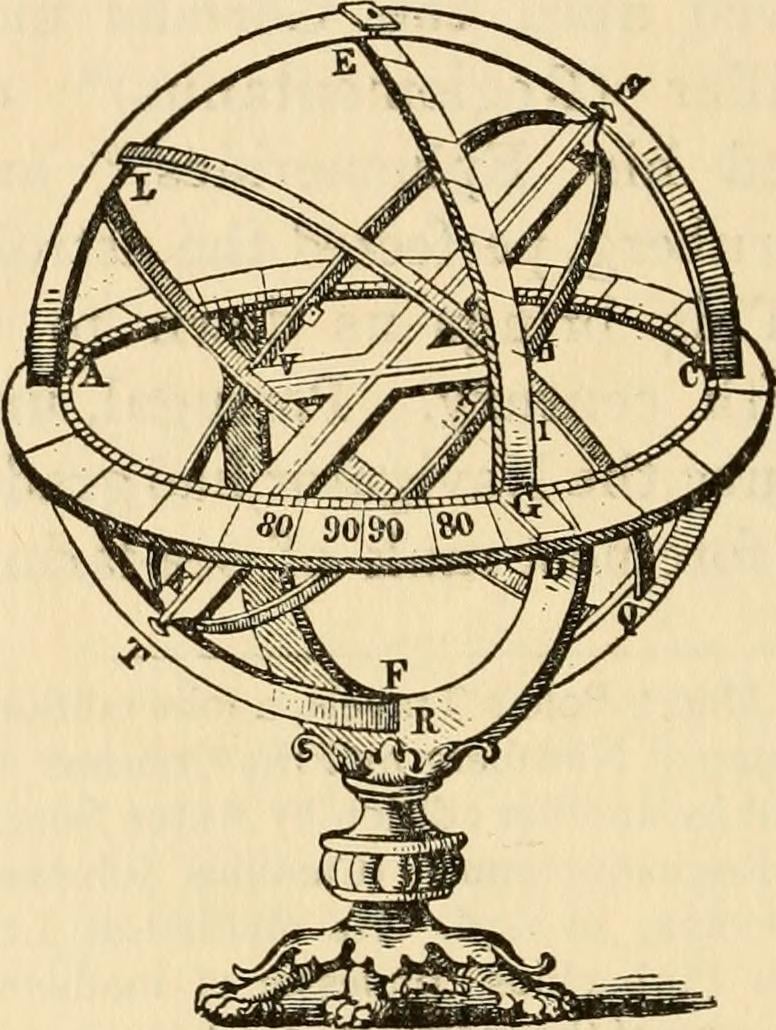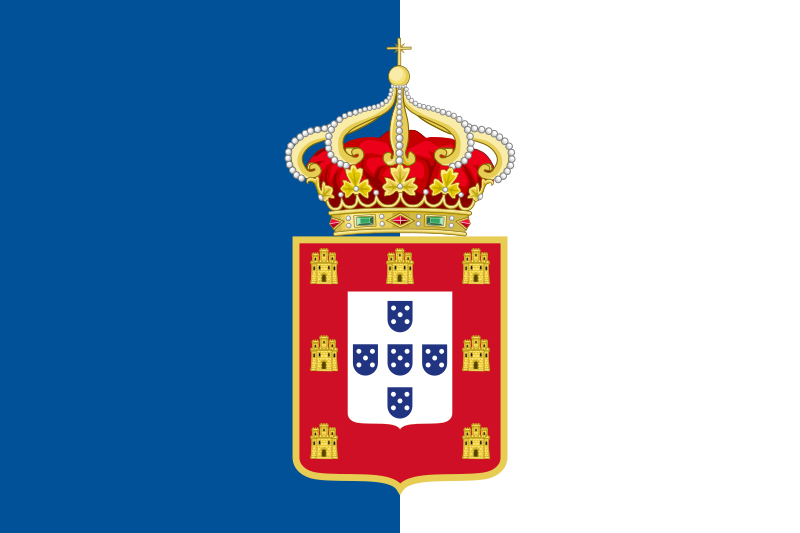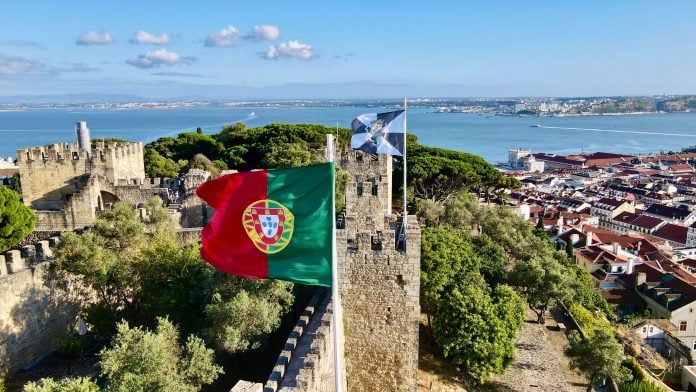The Portuguese flag of today was designed in 1910, after the revolution that overthrew the monarchy and proclaimed a republic on October 5. To get rid of monarchy symbols, a new national flag was created.
The flag was created by a special team including painter Columbano Bordalo Pinheiro and writer Abel Botelho. They were tasked with designing a flag that symbolized the new Portugal.
The flag as we know it is divided vertically into two main colors, green and red. The green part is smaller. On the center of the flag, you will find a yellow armillary sphere and a red shield.
But these colors and symbols weren’t chosen at random or for aesthetic purposes. They were selected due to their historical significance. So what is the true meaning of the Portuguese flag? Let’s take a look!
Meaning of the Portuguese Flag: What does Portugal’s Flag Mean?

Colors of the Portuguese Flag
The two main colors on the flag are green and red, decided by the flag committee. They believed red symbolized the blood loss of those fighting for Portugal to become a republic. Green symbolizes hope for the future. The Portuguese flag thus represents both the past and a glimmer of hope for the future.
There is more red than green on the flag, meaning there is more “blood” than “hope”. This represents the typical Portugal view, often focusing on the past and melancholy.
The old flag was white and blue, highly associated with the monarchy. It is no longer used, except for those who are monarchists.
However, even before 1910, red and green were present in historical symbols during important periods of Portuguese history. For example, during the 1640 revolution that restored Portugal’s independence from Spain, green symbols were present.
Green and red were also republican colors throughout the late 1800s and early 1900s, seen on every republican item. In the Republican revolt of Porto on January 31, 1891, the Portuguese Republican Party had flags with these colors.
Symbols in the Portuguese Flag
The two main symbols in the Portuguese flag are the armillary sphere, in yellow, and the Portuguese shield, in red. Let’s take a look at their meanings.
The Armillary Sphere

The yellow armillary sphere in the Portuguese flag features a ribbon design of four rings arranged on a sphere.
An armillary sphere is an astronomical device that was once sued to navigate oceans during the discoveries. It’s said that the device was introduced by Henry the Navigator, the Grand Master of the Order of Christ in the Knights Templar.
This device was incorporated into D. Manuel I’s flag during the discoveries. It also became a colonial symbol and a key element of the flags of the future Brazilian empire.
The flag designers placed an armillary sphere on the Portuguese flag to represent the “golden age” of maritime expansion during the 15th and 16th centuries.
Red Portuguese Shield
A Portuguese red shield lies at the center of the flag, on top of the armillary sphere. The whole shield represents Portuguese victories of the past.
The Portuguese shield is one of the oldest elements of the country’s flag, with a similar shield appearing during the reign of Sancho I. The shield was only not present on a flag during the reign of Afonso I.
The shield is divided into an interior white section with 5 smaller blue shields, and an outer red area with 7 yellow castles.
The 7 yellow castles on the red part represent the 7 castles that Portugal took back from the Moors during battles. These were captured under Afonso III in the Algarve in 1249.
The 5 smaller blue shields in the white area of the shield represent the 5 Moorish kings that were killed by Afonso I, the first King of Portugal. There are also 5 white dots within each blue shield representing the 5 wounds of Christ, the five wounds Christ suffered during the crucifixion.
History of the Portuguese Flag
The Portuguese flag has changed throughout the years. However, some form of the coat of arms has always been present.
Starting in 1095, the first flag-like symbol that can be associated with would become Portugal was placed on the shield of Henry of Burgundy, Count of Portugal. During his battle with the Moors, the count had a shield with a blue cross over white. This is where the white and blue that would once mark the last Portuguese monarch flag first appeared.
By 1248, the royal arms were also similar to the one of today. Under Afonso III of Portugal, a red border with yellow castles and a white interior with 5 blue shields was common. However, this coat of arms had a square shape.
In 1495, King Manuel I was the first king to convert the traditional square-shaped coat of arms to a more oval shape. The coat included the yellow castles and blue shields in the same colors that we see today, but with a crown on top, symbolizing the monarchy.
By the 17th century, King Peter II adapted the flag’s crown to fit with contemporary trends by adding a five-arched crown. A red beret was added under the crown by King John V in 1707.
By the 1800s, although Queen Maria II of Portugal was proclaimed queen at 7 years old, her brother Miguel disposed of her and proclaimed himself king. He abolished the 1822 liberal constitution and began ruling as an absolute monarch.
This led to a period of the Liberal Wars. The liberals formed a separate government in Terceira, Azores, and changed the national flag. The flag was divided between blue and white and the armillary sphere was removed.

King Miguel was later exiled in 1834 and Queen Maria II got her thrown back. The liberal flag was announced as the new national flag. It lasts for 80 years until the abolition of the monarchy in 1910.
Portuguese monarchists still use this flag but it is no longer the national flag. Rather, the green and red flag representing the republicans is still used, designed by a committee in 1910.


